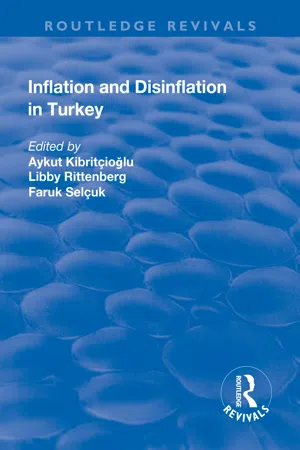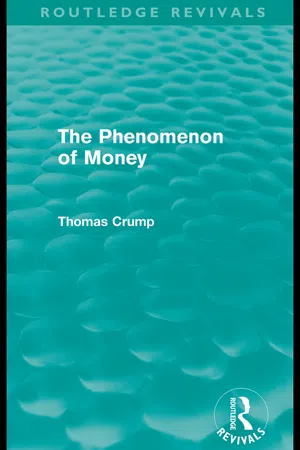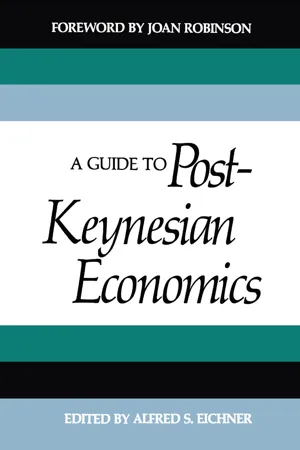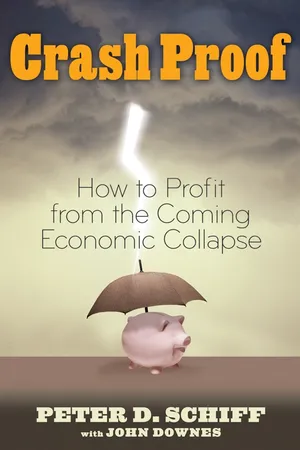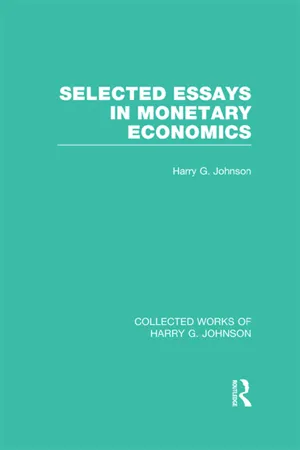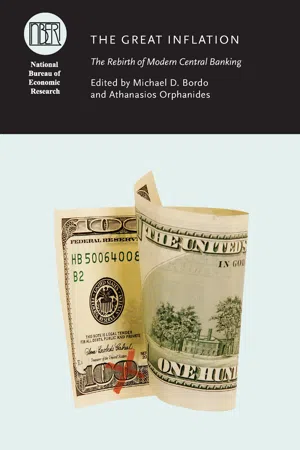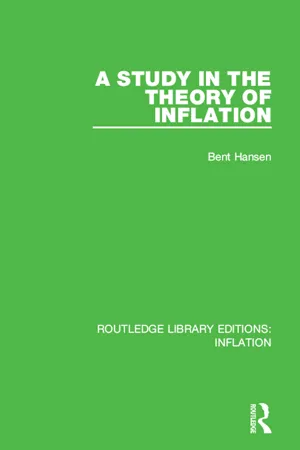Economics
Causes of Inflation
Causes of inflation can be attributed to factors such as excessive money supply, demand-pull inflation due to increased consumer spending, cost-push inflation from rising production costs, and inflation expectations leading to wage-price spirals. Additionally, external factors like changes in exchange rates and global commodity prices can also contribute to inflationary pressures.
Written by Perlego with AI-assistance
Related key terms
Related key terms
1 of 4
Related key terms
1 of 3
9 Key excerpts on "Causes of Inflation"
- eBook - ePub
- Faruk Selcuk, Libby Rittenberg, Aykut Kibritcioglu(Authors)
- 2018(Publication Date)
- Routledge(Publisher)
The time path of prices may also be influenced by the expectations, stickiness of prices/wages, and possible indexation experiences in the economy. Therefore, these inertial factors should be considered as a third block of explanatory factors of inflation. 21 The last block of explanatory factors of inflation seems to be offered by the new political macroeconomics. To model the dynamics of inflation more realistically, the political process, or the role of institutions, must also be considered explicitly. Most of the theoretical discussions on Causes of Inflation above are based on the assumption that financial markets are highly developed and functioning very well in the presence of necessary laws and rules. However, this is not the case in many high-inflation developing countries. Thus, the political or institutional approach to economics suggests that one should take into account the institutional, political and cultural changes in such economies, and modify the model to explain high-inflation accordingly. In my view, as a conclusion, the complex and dynamic interactions of four groups of factors (i.e., demand shocks, supply shocks, inertial factors and the political process) come together to explain inflation in any economy. 3. Empirical Studies on Turkish Inflation After reviewing the theoretical discussions on Causes of Inflation in the previous section, I attempt now to survey the large empirical literature on determinants of inflation in Turkey. This survey is limited to those empirical studies that investigate explicitly the sources of Turkish inflation while the plentiful contributions on disinflation processes are consciously excluded. 22 This section is divided into two subsections to discuss the evidence on the causes and dynamics of pre-1980 and post-1979 inflations separately. There are many reasons for this. First, Turkey experienced a radical structural change in the 1980s, as discussed more fully by Ertuğrul and Selçuk in Chapter 2 in this book - eBook - ePub
- Thomas Crump(Author)
- 2011(Publication Date)
- Routledge(Publisher)
This explains why ‘cost-push’, which is the alternative to ‘demand-pull’ inflation, is much easier to live with. In any sector to which it applies, it means that the prices of outputs have to be increased ‘defensively’, simply because of the increased cost of inputs—such as labour, or imported raw materials (Flemming, 1976, p. 12). Everything is blamed on the trade unions, or on the OPEC lands (particularly those whose religion is Islam). This latter case has the advantage of being able to show that the inflation is triggered off from outside the sphere of payment, allowing the authorities to adopt a convenient air of injured innocence.In considering the Causes of Inflation one is confronted with a vicious circle. There are quite logical arguments to prove that neither ‘cost-push’ nor ‘demand-pull’ can be a cause of inflation (Machlup, 1969, pp. 151f.). Inflation is in fact a vicious circle, and ‘demand-pull’ and ‘cost-push’ are little more than two sides of the same coin. So also, once inflation is started, is it difficult to distinguish between cause and effect, a point to be borne in mind in the following section.The consequences of inflation
The consequences of inflation are twofold: the redistribution of purchasing power and the revaluation of assets and liabilities. As to the first, each separate sector in the economic complex sees its money income increased at different stages in the inflationary cycle. For every such sector two factors are critical: the first is the amount of the increase accruing to it; the second, the time at which it occurs. The significance of the first factor may be evaluated in terms of the share of the sector concerned in the aggregate flow of money—MV in Fisher’s equation. The immediate result of an increase in the income accruing will be to increase this share, and although this must lead to a decrease in the share of other sectors, this need involve no loss in real terms so long as it corresponds to a rateable increase in productivity. That is, an increase in MV is not inflationary, so long as it leads only to an increase in T, with P remaining unchanged. If, however, this does not happen (which is the general case), the increase in P - eBook - ePub
- Krish Bhaskar, David F. Murray(Authors)
- 2015(Publication Date)
- Routledge(Publisher)
Figure 15.1 . The effect of this is to generate a greater increase in the price level for a given movement in the aggregate demand curve.One source of theories of inflation is therefore concerned with the factors affecting the aggregate demand curve since this in turn affects the price level. These are the so-called demand pull theories. The second main approach to the theory of inflation is generally known as cost push inflation and considers the factors which might produce a leftward shift in the aggregate supply curve as shown in Figure 15.2 and hence cause an increase in the price level.Figure 15.2 The effect on the price level of a decline in aggregate supplyThe crucial point to notice about cost push inflation here is that it is associated with cuts in real income. Thus if the economy is at equilibrium at full employment, Yf , before the shift in the aggregate supply curve the inflation resulting from the shift is accompanied by a move to a less than full employment position and hence an under-utilisation of capacity.As an aside it should be remembered that in the previous chapter it was argued that changes in the money wage can cause movements in both the aggregate supply and aggregate demand curves. In this situation it becomes difficult to identify the cause of inflation as cost push since the precondition of demand pull is also satisfied.It is perhaps worth emphasising at this early stage that while demand pull and cost push theories of inflation are often presented as alternative theories of the initial cause of an inflationary situation, they may more usefully be viewed as the means by which inflation is transmitted through the economic system regardless of its starting point. In the first part of the chapter we shall discuss each of these transmission mechanisms and within our discussion endeavour to encompass both classical and Keynesian views of inflation. - eBook - ePub
- Alfred S. Eichner(Author)
- 2023(Publication Date)
- Routledge(Publisher)
While economic crises always produce unemployment, in recent years they have also been accompanied by inflation. The recent world inflation is widely regarded as having begun in the United States as a response to excess demand growing out of deficit-financed war expenditures for Vietnam. This inflation was propelled onward and outward by synchronous booms throughout the capitalist countries which greatly augmented aggregate demand for world resources. The prolonged boom of the 1960s and the demand-pull inflation that it created in turn produced cost-push pressures which have persisted into the world recession of the 1970s, and account for the current state of stagflation. Inflation now coexists with unemployment mainly because the working classes have gained and retained sufficient political and economic strength to battle more evenly with capital over shares of the national income.The causes of inflation
The contemporary orthodox division of economics into two parts, microeconomics and macroeconomics, grew out of the earlier Marshallian division of the subject into the theory of value and the theory of money. In microeconomics, supply and demand interact to determine relative prices through the application of either Marshallian partial-equilibrium or Walrasian general-equilibrium analysis. Modern macroeconomics, in the version that has come to be identified as the “neoclassical synthesis,” lumps together the old quantity theory of money, which determines the level of absolute prices, with a bastardized version of Keynes centering on how price rigidities may prevent the economy from actually reaching full-employment equilibrium.For modern post-Keynesians, in contrast, the rate of inflation is determined primarily by the rate of increase of nominal money wages relative to labor productivity. Over wide sectors of the economy, prices are largely cost-determined, based on a mark-up over unit labor costs. (The main exceptions are the agricultural and raw materials sectors where prices are still jointly determined by supply and demand.) This mark-up of prices over unit labor costs will be constant over time for the economy as a whole so long as the capital and labor shares of national income are constant, irrespective of the assumptions governing price-setting behavior. So long as factor shares are constant, a constant mark-up will result even if all markets are assumed perfectly competitive and the neoclassical assumption made that all factors are paid the value of their marginal products. A rise in raw material prices, a rise in the share of national income going to government, and an increase in the rate of investment expenditures will all tend to lead to a higher mark-up, reducing real wages by driving a larger wedge between unit wage costs and prices. - eBook - ePub
Crash Proof
How to Profit From the Coming Economic Collapse
- Peter D. Schiff, John Downes(Authors)
- 2010(Publication Date)
- Wiley(Publisher)
Consumer price index, year-over-year change, 1997-2006. Even the government’s own highly flawed and greatly manipulated index revealed inflation was accelerating even as the government and Wall Street claimed that it was well contained. By the time the problem was partially acknowledged, the government’s response was too little and too late.Source: Reprinted by permission from David L. Tice and Associates (www.prudentbear.com ).WHAT INFLATION IS AND ISN’T
Inflation means expansion, in the same sense that a balloon expands when you blow air into it. In economics, inflation refers to expansion of the amount of dollars in circulation, called the money supply. When new money or credit is added to an economy, thus diluting the existing supply, the general level of prices (aggregate prices) will rise, assuming the amount of goods and services within the system stays the same. But understand the distinction: The money supply expands and contracts. Prices go up and down. Inflation and price increases are not the same thing. One is cause. The other is effect.The reason that expansion of the money supply causes aggregate prices to rise is simple. As the supply of dollars grows relative to the supply of goods, more dollars are needed to buy a given quantity of goods. In other words, the dollar’s value is diminished relative to the goods available for sale. It’s basic supply, represented by sellers, and demand, represented by buyers. Any kid who collects baseball cards understands it. The more a particular card is in circulation, the less it is worth. The value of a card is a function of its scarcity. The more abundant the supply, the less something is worth. The same holds true for money.HOW INFLATION CREATES ARTIFICIAL DEMAND
So inflation is monetary expansion or, in other words, more money chasing a constant or diminishing supply of goods and services. It doesn’t have to be physical dollars added to the supply of money. It can just as well be expanded credit. Anything that artificially increases aggregate demand for goods and services is inflation. Printing money - eBook - ePub
Trading Economics
A Guide to Economic Statistics for Practitioners and Students
- Trevor Williams, Victoria Turton(Authors)
- 2014(Publication Date)
- Wiley(Publisher)
3Demand-Pull Inflation
Demand-pull inflation occurs when demand in the economy exceeds its ability to supply that demand. An aggregate supply (AS) and an aggregate demand (AD) diagram can also illustrate this point (see Figure 4.7 ), this time with the demand curve shifting to the right while supply stays put.Figure 4.7Demand-pull inflation – arises when aggregate demand in an economy outpaces aggregate supply. AD, aggregate demand; AS, aggregate supply; Y, real output.Source: Own calculations.Demand-pull inflation is considered to arise when aggregate demand in an economy outpaces aggregate supply. It involves inflation rising as real GDP rises and unemployment falls. This is commonly described as ‘too much money chasing too few goods’. This assumes that all available resources in the economy are fully utilised, including employment and investment and raw materials.According to Keynesian theory, the more firms that are prepared to employ people, the more people will be employed. The aggregate demand (AD) will become greater and will make firms employ more people in order to produce more output. Due to capacity constraints, this increase in output will eventually become so small that the price of the good will rise. At first, once this occurs, unemployment will go down, shifting AD1 to AD2 , which increases demand (Y) by (Y2 – Y1 ). This increase in demand means more workers are needed, and thus AD will be shifted from AD2 to AD3 . However, this time, much less is produced than in the previous shift, but the price level has risen from P2 to P3 - Harry Johnson(Author)
- 2013(Publication Date)
- Routledge(Publisher)
Figure 1 underlying the behaviour of the six economies undergoing hyper-inflation. Brown’s study, which assembles a great deal of information without analysing it with the same rigour as Cagan, confirms the quantity theory approach in a number of ways; for example, Brown finds no clear evidence of the wage lag of World War I popular belief and many of the Keynesian models, and shows that inflations do not necessarily tend to ‘gallop away’, countries having experienced inflations of up to one hundred per cent per annum and more without the inflation accelerating into hyper-inflation. So far as substantial inflations are concerned, the evidence therefore seems to favour the quantity theory approach over the Keynesian approach. For the mild type of inflation typical of the United States and other advanced countries in recent years, however, the approach has not proved nearly so useful. The theory implies the existence of a stable demand function for money in which the expected rate of inflation appears as one of the arguments; but while many researchers have established the existence of satisfactorily stable demand functions for money for such countries, the expected rate of price change has not appeared as a significant determinant of the quantity of money demanded. This might be accounted for on the hypothesis that the public only becomes sensitive to inflation after a certain threshold rate of price increase has been passed, or that recognition that the situation has been characteristically inflationary comes only with a very long lag. Whatever the reason, the theory has not succeeded in providing as convincing an explanation and method of analysis of mild as of strong inflations. Neither the Keynesian nor the quantity theory approach to inflation, of course, is very well adapted to dealing with the problems of suppressed inflation.V. COST-PUSH VERSUS DEMAND-PULL INFLATIONAs mentioned in the brief historical sketch of inflationary experience provided in an earlier section, the issue of whether inflation is the consequence of the upward push of costs or the upward pull of demand on prices became a lively issue in the late 1950s in the United States as a consequence of the coexistence of an apparent upward trend of prices with a higher average level of unemployment than had characterized the immediately preceding period. It is necessary, however, to resist the temptation to think of this problem as a specifically American problem developed in that period, for the issue began to be debated in the United Kingdom and other European countries very soon after the War. The importance of the debate stems largely from the difference between the recommendations for anti-inflationary policy to which the two views of the cause of inflation lead, the demand-pull explanation leading to the recommendation of monetary restraint and fiscal orthodoxy and the cost-push explanation leading to the rejection of macro-economic measures of this sort in favour of policies directed at the processes of price formation and wage determination. The difference in policy recommendations is not entirely a difference between right-wing conservative and left-wing radical solutions, since fiscal policy can be directed to radical objectives, while on the other hand the alternative policies recommended have covered a very wide range. In fact, these recommendations have ranged from direct wage and price fixing, or the establishment of national wage or income policies to be implemented by voluntary co-operation of business and labour with ‘guide lines’ laid down by government, through trust-busting or union-busting policies, to policies designed generally to improve the mobility of labour and the efficiency of competition in the economy, such as were recommended by the American Commission on Money and Credit.1- eBook - ePub
National Bureau of Economic Research Conference Report
The Rebirth of Modern Central Banking
- Michael D. Bordo, Athanasios Orphanides, Michael D. Bordo, Athanasios Orphanides(Authors)
- 2013(Publication Date)
- University of Chicago Press(Publisher)
Economic Trends observed,The retail price index rose by about 1/2 per cent in June. . . . The increase in June was largely the result of higher prices for fresh fruit and the reintroduction of prescription charges, which were only partially offset by lower potato prices. (H. M. Treasury, “The Economic Situation,” in Economic Trends , August 1968, vii)An analysis like this might be appropriate for analyzing erratic monthly movements in the price level, but the Treasury carried it over to the analysis of longer-term inflation movements. And in explaining inflation movements at a level deeper than referring to movements in specific components of the price index, the Treasury appeared satisfied to appeal to the relation between prices and costs:The main factor sustaining this continuing high rate of price increase has been the rapid advance in wage costs. (EPR , November 1970, 6)The factors underlying the rise of prices have, however, changed. The initial acceleration was mainly a result of the effects of devaluation on import prices. . . . Since last autumn, however, a different pattern has emerged. . . . [T]here has been a very marked rise in costs resulting mainly from the fast rise in money wages. (EPR , January 1971, 6.)A higher level of pay settlements was much the most important factor in the faster rise of costs and prices during 1970. (EPR , May 1971, 5)The slow rise in the prices of basic materials and fuel in recent months has, however, been more than offset by the strong rate of increase in wage costs, which have become the dominant influence on price rises. (EPR , June 1975, 6)The prevalence of cost-push explanations for inflation at the official level across the 1970s indicates that exogenous cost shocks were not being cited simply to account for short-run movements in inflation, but for sustained movements too. This reflected the UK Treasury’s uncritical acceptance of the notion that “the phenomenon of persistent inflation reflected a cost-push—and specifically wage-push—progress, associated with modern collective bargaining procedures (EPR - eBook - ePub
- Bent Hansen(Author)
- 2016(Publication Date)
- Routledge(Publisher)
Geldzins und Guterpreise. Although these theories of inflation work with a difference between investment and saving as the driving force of inflation, the crux of these theories is, however, that this difference is taken to be identical with the existence of an excess demand which forces up both commodity prices and factor prices alternately. We shall go fully into the way the difference between planned investment and saving is connected with excess demand in the next two chapters, and show that it is not of quite the simple character that has been assumed in these theories. Here, however, it is important to note that these theories take the factor-markets and their excess demands as an essential link in the chain of causation which leads to rises in commodity prices and factor prices. Further, that what is thus dealt with is clearly what we have called induced price-increases. The inflation analysis of the following chapters may therefore be said to cover the field which the Wicksellians have investigated.On the other hand, we have those authors who to some extent take their starting point and inspiration in J. M. Keynes’s How to Pay for the War (together with some stray ideas in The General Theory of Employment, Interest, and Money).1 In that little book Keynes put forward a rather sketchy analysis of inflation, which in certain respects resembles the Wicksellian analysis, in so far as it considers excess demand for commodities as the driving force behind rises in commodity prices. But the picture of inflation is somewhat different, because the disequilibrium in the factor-markets comes in the background as a causal factor in the process.This is even more noticeable in the authors who have developed Keynes’s ideas from How to Pay for the War. With these authors it is only in the commodity-markets that excess demand appears as the driving force behind price increases; the factor-markets, which as a rule comprise only the labour-markets, are dealt with simply by assuming full employment, and nothing more. This is of course not equivalent to considering the wage-rates as constant, but it is equivalent to considering the rises in wage-rates which occur as only spontaneous. These authors, for instance, introduce a certain “coefficient of wage-adjustment”, which tightly connects the development of money wages with the development of prices, in the way which occurs when money wages are regulated according to a cost-of-living index.1 The fact that there is full employment then only signifies that a maximum for total production is thereby fixed (that is undoubtedly important), but it neglects the point that an excess demand for labour-services can exist, i.e. that there can be overfull employment.2
Index pages curate the most relevant extracts from our library of academic textbooks. They’ve been created using an in-house natural language model (NLM), each adding context and meaning to key research topics.
Explore more topic indexes
Explore more topic indexes
1 of 6
Explore more topic indexes
1 of 4
